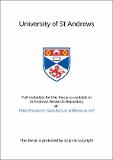Files in this item
Spiral waves in accretion discs
Item metadata
| dc.contributor.advisor | Horne, K. (Keith) | en |
| dc.contributor.author | Steeghs, Daniel Theodore Hubert | en |
| dc.coverage.spatial | 119p | en |
| dc.date.accessioned | 2021-04-08T09:04:21Z | |
| dc.date.available | 2021-04-08T09:04:21Z | |
| dc.date.issued | 2000 | |
| dc.identifier.uri | https://hdl.handle.net/10023/22023 | |
| dc.description.abstract | This thesis discusses observations of the interacting binary IP Pegasi and shows that its accretion disc carries strong, tidally driven spiral arms during outburst. The distribution of line emission across the accretion disc is resolved using Doppler tomography and reveals a two armed spiral pattern in a variety of emission lines. The spirals persist as a strong corotating pattern throughout the outburst maximum for at least 8 days, while the disc radius decreases exponentially. During quiescence, the disc lacks such open spirals but remains non-axisymmetric. Hydrodynamical simulations are used to calculate the properties of thin accretion discs carrying tidal density waves. Predicted emission line properties and simulated image reconstructions reproduce the observations in detail and confirm that the spiral structure observed in IP Pegasi is a tidally driven phenomenon. The IP Pegasi observations provide the first convincing evidence for tidally driven spirals that were proposed over 13 years ago as a possible source of angular momentum transport in accretion discs. The disc simulations also indicate that similar disc structure is expected in other systems carrying large discs such as dwarf novae in outburst and nova-like variables. For small, cool accretion discs, tidally driven spiral waves can be present but are too tightly wrapped to be resolved in the strong emission lines. It is clear that tidally driven waves can severely alter the global dynamics and structure of accretion discs. However, a significant amount of shear viscosity is still needed to switch from a small disc in quiesence to the large disc observed in outburst so that strong open spirals are generated. How much angular momentum can be transported via such waves in comparison to angular momentum dispersal through local viscous processes remains to be quantified by comparing realistic model calculations with present and future observations. | en |
| dc.language.iso | en | en |
| dc.publisher | University of St Andrews | en |
| dc.subject.lcc | QB421.S8 | |
| dc.subject.lcsh | Accretion (Astrophysics) | en |
| dc.title | Spiral waves in accretion discs | en |
| dc.type | Thesis | en |
| dc.type.qualificationlevel | Doctoral | en |
| dc.type.qualificationname | PhD Doctor of Philosopy | en |
| dc.publisher.institution | The University of St Andrews | en |
This item appears in the following Collection(s)
Items in the St Andrews Research Repository are protected by copyright, with all rights reserved, unless otherwise indicated.

